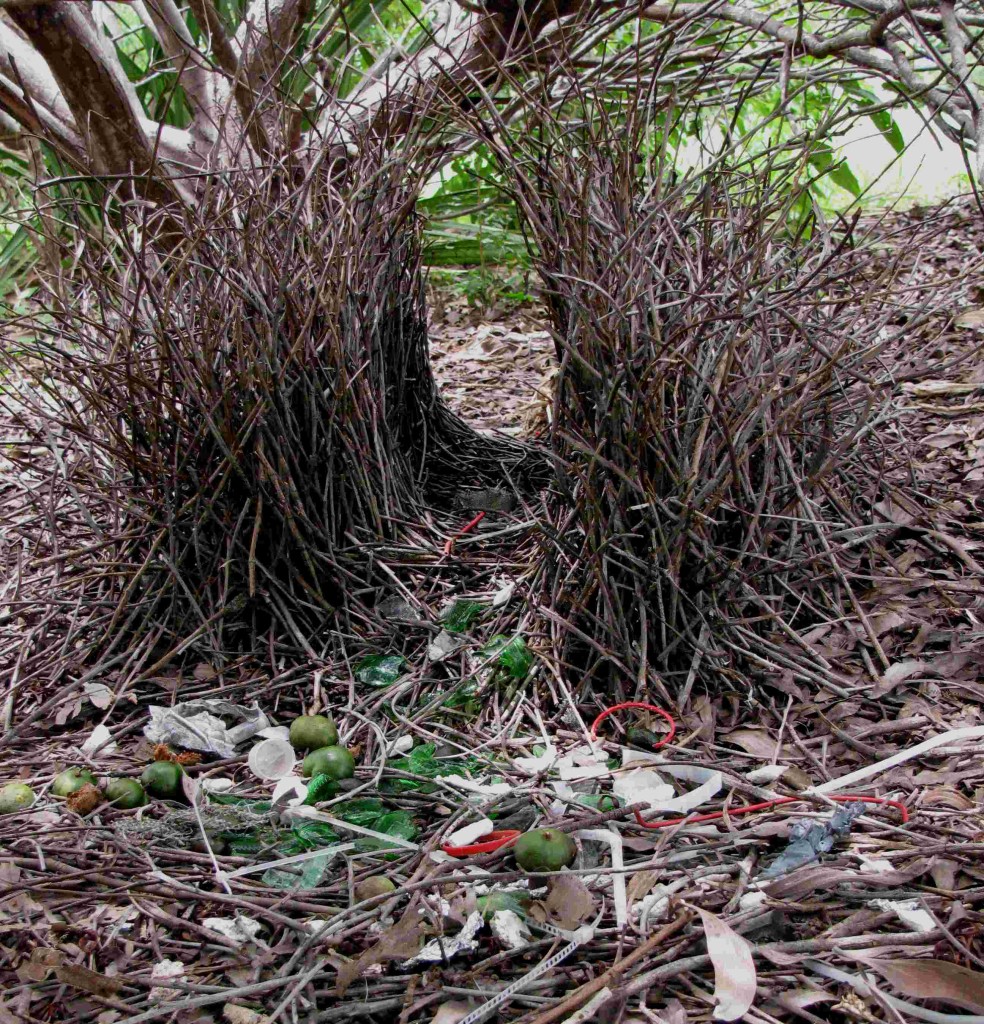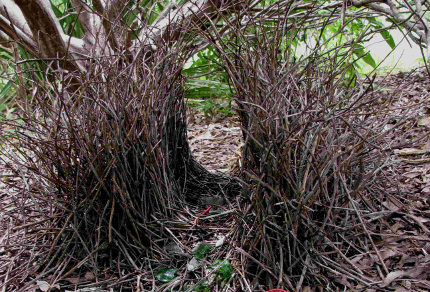Early this morning, I rose from sleep and headed to the Ross River Parkway for a bash of birding, the highlight of which was sighting a great bowerbird – fawn-coloured with a brown, grey-scalloped dorsal plumage – flushing from a clump of shrubs and low trees, carrying an object in its beak. It occurred to me that the bowerbird might be a male that had stolen a decoration from another male’s bower.
I continued along the path until I reached the vegetation from which the bowerbird had flown, and then scanned beneath the shrubs for distinctive, upright walls of dark twigs. I spotted the bower, surrounded by fewer decorations than the large bower Chris Johnson had shown me at the James Cook University campus. At this bower, the green decorations were strictly pieces of broken glass, while the creamy decorations consisted of pale stones, two short, white drinking straws, and numerous bits of old aluminium foil. A few pinkish-red bits of weed-whipper plastic rounded out the decorations, which were primarily concentrated at one entrance. I felt as though I had found a gift simply set out in the park, waiting for me to discover it.

Great Bowerbird Bower (© Magi Nams)

Santa on a Palm (© Vilis Nams)
While house-hunting by car in early afternoon, Vilis spotted Santa climbing a palm tree in a residential front yard. There were no reindeer in sight.
Also while driving, we heard on national radio that the southern state of Victoria has reached the catastrophic level of bushfire danger. South Australia has also issued the catastrophic warning in 10 of its 15 fire districts. Residents were reminded to have an escape plan in place, and people living in outlying areas were encouraged to evacuate into townships or rural cities early in the day on days when the fire risk was catastrophic. Listeners were reminded that the worst place to be when you see the flames coming is in a car, trying to escape when it’s too late.1
Last year, bushfires ravaged the southern states, particularly Victoria. The most catastrophic of these occurred on Saturday, February 7, since called Black Saturday. Scorching temperatures in the upper 40°’s (Melbourne recorded an all-time Australian capital city record of 46.4°C; Marysville recorded 48°C), along with humidities as low as 6% and 100- to 125-kph winds on the tail end of a heat wave set the scene for a disaster.2,3 In addition to fires already burning, new fires broke out, the most destructive of these exploding into a firestorm that swept through a vast area northeast of Melbourne and killed 120 of the 173 people that died in bushfires that day.2 Moving at a shocking speed, this firestorm, which essentially destroyed Marysville, travelled 25 kilometres in four minutess.* Nothing like it had ever been seen before, in the time since Europeans arrived on this continent.3
During the evening, Vilis and I walked the Ross River Parkway north to Boundary Road and then returned with dusk stealing in around us. As we neared Queens Road, dark shapes flying above the treetops caught our attention. Vilis commented that they flew like bats, with quick, stiff wingbeats. The aerialists were a foot long and black, with chunky bodies and no tails. Their wings looked tight, taut, and moved with a smart snapping motion. When one of the fliers swooped in low over our heads, we observed that its wings were translucent skin, and could see little feet hanging behind its body, indicating that it was definitely a bat.
More of the stocky black fliers that streamed past overhead all headed in the same direction – west. We hurried home to Richard’s, where I colleced my copy of A Field Guide to the Mammals of Australia (written by Peter Menkhorst and illustrated by Frank Knight) from the guestroom and flipped through its pages of bats. And there it was, Pteropus alecto, the black flying fox, its dark, tailless body illustrated at roost and in flight,4 its scientific name sounding like a curse Harry Potter would cast from his wand at a Deatheater. Pteropus alecto! In reality, it means “wing-footed” “tropical-subtropical.”
“They form ‘large, permanent camps for daytime roosting’,” I read to Vilis from the guide, “and feed mostly on the ‘nectar of eucalypts, melaleucas, turpentines, also fruits, including citrus and mangoes, some leaf material. May travel up to 50 kilometres each night in search of flowering or fruiting trees.’4 Wow!”
“Fifty kilometres? How do they know where to go?”
“Maybe they follow the river, at least part of the way.”
So many questions. Flying foxes are the giants of the bat world, possessing the largest body sizes, which can exceed a kilogram in weight, along with a wingspan of a metre and a half or more.5 They occur in tropical and subtropical ecosystems from Madagascar east through India and Southeast Asia, and south to Australia.5 This continent possesses eight species of flying foxes, with the black flying fox the second largest of these after the grey-headed flying fox.4,5 Simply having seen these quintessentially tropical mammals has, for me, pried open the corner of an entirely new window into ecology.
References:
1. ABC AM. Catastrophic fire warnings for Victoria and South Australia. January 11, 2010. © 2010 ABC. Accessed 25-Nov-2010. http://www.abc.net.au/am/content/2010/s2789255.htm;
2. 2009 Victorian Bushfires Royal Commission – Interim Report. © Victorian Bushfires Royal Commission, Australia. Accessed 25-Nov-2010. http://www.royalcommission.vic.gov.au/Commission-Reports/Interim-Report/Chapters/The-February-2009-Fires
3. Wikipedia. Black Saturday bushfires. Updated 23-Nov-2010. Accessed 25-Nov-2010. http://en.wikipedia.org/wiki/Black_Saturday_bushfires
4. Peter Menkhorst and Frank Knight. A Field Guide to the Mammals of Australia. Oxford University Press, South Melbourne, Victoria, pp. 142-143.
5. Leslie Hall and Greg Richards. Flying Foxes: Fruit and Blossom Bats of Australia. 2000. University of New South Wales Press, Sydney, p. 2-3.
*I heard this fact on the radio but was unable to track down the exact source.


